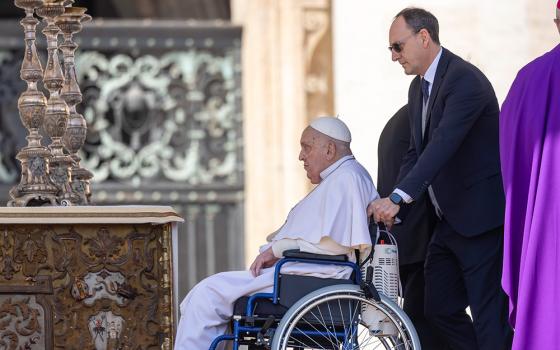
When Wichita Bishop Eugene Gerber delivered his homily at the 1999 ordination of his new coadjutor bishop, Thomas J. Olmsted, he addressed prescient words directly to Olmsted.
The crucifixion-resurrection paradoxes of Christianity, he said, “will both raise you up and weigh you down in ways you have never experienced, I suspect. They will cause you both to rejoice and to weep with the deepest emotion, like Christ himself.”
Olmsted may have experienced some of that whiplash pressure in his four years in Wichita, where he eventually served as bishop, but nothing like what he’s going through now as bishop of Phoenix.
“I’m sure he’s lost some sleep over this,” says Msgr. Robert Hemberger, who served Olmsted in Wichita as chancellor and later as vicar general, his current position.
The “this” to which Hemberger refers is a national controversy over Olmsted’s role in a Phoenix nun’s excommunication for her part in approving an abortion at a Catholic hospital there.
And yet Hemberger was not surprised when he learned Olmsted had declared that Sister Margaret McBride had, by her actions, excommunicated herself.
“He’s very, very much on policy,” Hemberger said of Olmsted. “Whatever issue would come up he’d say, ‘What’s our policy on that?’ He’s a very policy-oriented kind of a person. His idea behind that is that he wanted to be consistent.”
Hemberger also knew that Olmsted is “firmly, absolutely, vigorously committed to pro-life issues and the unborn. So I wasn’t surprised (about the excommunication) in light of his convictions.”
Hemberger’s description of Olmsted’s approach to being a bishop squares with descriptions used not just byChris Carpenter, a former Catholic priest in Phoenix who incurred excommunication under Olmsted last year, but also by others who were unwilling to speak on the record because Olmsted still is in a position to affect their careers.
Here’s a description of Olmsted from Carpenter, who was excommunicated for joining a movement not in communion with the Catholic Church and who now works in California as a priest for that group, the Reformed Catholic Church: “He’s very much governed by canon law and obedience and fidelity to church teaching and the magisterium and the institution. There’s no compromise with him. There’s no real dialogue with him. Olmsted likes to present himself publicly as gentle and compassionate, but that is not my personal experience of him.”
And here are comments from others who declined to be named:
• “He is a man of the rules and very much a company man” who puts the institutional church ahead of people.
• He shares Pope Benedict XVI’s understanding of church and Vatican II in that Olmsted is in the “Vatican II revisionist school.”
• Soon after arriving in Phoenix in 2003 he began “hammering” home the importance of being against abortion, against gay marriage, against birth control and more. Indeed, he began requiring anyone wanting a wedding in the diocese to attend a full course on natural family planning. But he took this approach without spending much time with many of the 450,000 people in the diocese to understand their needs and hopes.
The only thing that took Hemberger back a bit was that the story of the nun’s excommunication went so public. But even that offers an insight into Olmsted’s approach.
Olmsted certainly would have preferred to keep the story quiet. But a reporter for the Arizona Republic ferreted out what had happened, causing Olmsted to issue a formal public statement.
Olmsted’s reluctance did not surprise the reporter, Mike Clancy, who said, “It confuses me when a man in his position is so media shy, which contrasts with his predecessor” (Bishop Thomas O’Brien, a much more public, gregarious man who resigned in June 2003 after being charged with leaving the scene of a fatal auto accident).
Clancy’s description of Olmsted as media shy was confirmed when, in response to a request for an interview for this story, Robert DeFrancesco, communications director for the Phoenix Diocese, checked with Olmsted and replied simply, “The bishop is unavailable for interviews at the present time.”
So who is this man whom Hemberger said “was policy-driven but yet very kind person to person?”
It helps to know that he grew up on a Kansas farm north of Marysville near the Nebraska border and attended a one-room rural school. That information, however, isn’t nearly as revealing as a comment Olmsted’s mother, Helen Olmsted, made to the Wichita Eagle at the time of his ordination as coadjutor bishop. In describing the farm of Olmsted’s youth, she said: “This farm hasn’t changed one iota since he left it, and we feel that’s good.”
Clearly, then, he grew up with the values of constancy and tradition and, perhaps, even with an aversion to change.
It also helps to know that he’s been tutored by and worked under some religious leaders who, with respect to canon law and the faith itself, are strict constructionists.
Students under such teachers generally do one of two things: Either they rebel and find a different path or they, too, become strict constructionists.
Tom Olmsted did not rebel. Among those whom Olmsted, as a Nebraska priest, watched as he learned what it took to be a bishop was Fabian W. Bruskewitz of Lincoln, Neb., one of the few bishops in the 2004 presidential election who declared he would refuse to serve Communion to Sen. John Kerry or to other “manifest, persistent, obstinate sinners, including politicians, regardless of which diocese they are from.” Between two assignments in Nebraska, Olmsted spent time in Rome, where, for more than a decade, he was an assistant at the Secretariat of State of the Holy See, not typically a boiling cauldron of innovation.
This does not mean Olmsted became simply a soulless church bureaucrat. Even most critics think that would be an unfair description. People who know him almost invariably describe him as warm, even humorous and charming, especially in more private settings. One put it this way: “He is an ascetical person, a bit shy and timid, yet personable and attentive in conversation. He is prayerful, but very introspective when presiding at liturgy.” Another called him “humble, prayerful.”
Yet someone who also has experienced Olmsted’s persona in more public settings said that at times he “seems to be a cold fish. He doesn’t really relate to people very well.”
Whether charming or stiff-necked, what Olmsted seems to rely on when push comes to shove are the rules, especially those of Holy Mother Church. But is it fair to say he’s more interested in the letter of law than its spirit? Hemberger’s answer:
“I don’t think that would be fair. He is a very personable person. And I’m sure he wrestled on this one, (the nun’s excommunication) as he does everything, over, ‘How do I balance the individual good and the common good?’ He wrestled with those questions regularly but generally it was for the sake of consistency. He’d say, ‘Well, the policy needs to work.’”
If Olmsted found policies he didn’t like would he be open to changing them? Again, Hemberger:
“He was very receptive to changing policy, although that would depend on which level it came from. If it was universal law, he’d say, ‘Well, that’s universal law of the church.’ If it was individual policy of the diocese, he’d say, ‘How did it get to be? And why is it? And does it still work?’ He’d readily question that.”
So when confronted with the case of a nun who was a member of a hospital ethics committee that approved an abortion to save a mother’s life, Olmsted went right to canon law. Clearly he saw no wiggle room.
In the public statement Olmsted released after the excommunication became known he said: “An unborn child is not a disease. While medical professionals should certainly try to save a pregnant mother’s life, the means by which they do it can never be by directly killing her unborn child. The end does not justify the means.”
Some reporting on this story has left the impression that Olmsted simply excommunicated Sister Margaret. Technically that’s not correct.
Canon law sets up provisions for a “latae sententiae” (or automatic) excommunication. Olmsted, thus, reviewed the facts of the case — perhaps speaking to Sister Margaret herself, though no one personally involved in what happened has confirmed that — and then simply informed her that she had excommunicated herself because she participated in the decision to terminate an 11-week pregnancy. (Carpenter says Olmsted never spoke with him before sending him a lengthy letter — Carpenter called it a “diatribe” — telling him he had initiated a canonical investigation of the priest. In the end there was no Olmsted-Carpenter conversation at all, just an exchange of letters.)
There has been much debate in the church and the media about whether Olmsted did all he could to achieve a different outcome, given that the purpose of excommunication is to reconcile the offender with the church.
And no doubt that debate will continue, even among people inside and outside the church who know little or nothing about canon law.
But what seems clear — even without the opportunity to hear Olmsted explain his action in response to media questions — is that in this case he acted in complete harmony with his career’s strict-constructionist, rule-based approach to ministry.
Bill Tammeus, a Presbyterian elder and former award-winning Faith columnist for The Kansas City Star, writes the daily “Faith Matters” blog for The Star’s Web site and a monthly column for The Presbyterian Outlook. His latest book, co-authored with Rabbi Jacques Cukierkorn, is They Were Just People: Stories of Rescue in Poland During the Holocaust. E-mail him at wtammeus@kc.rr.com.
NCR reporting on the Phoenix-excommunication case
|





